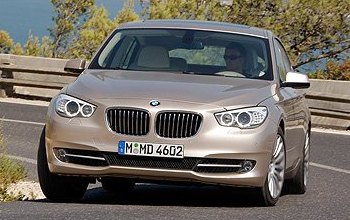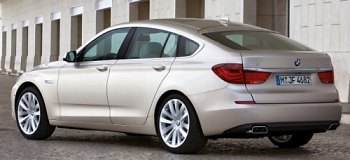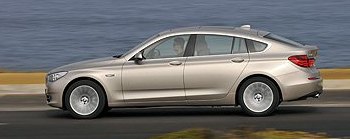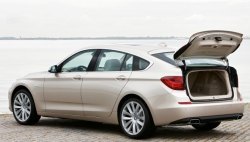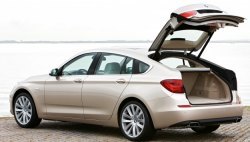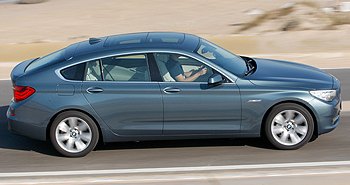BMW 5-Series GT (F07)
Debut: 2009 |
|||||||||||
20 years ago BMW's product lineup consisted of only 3, 5, 7 and 8 series. Since the mid-1990s, its product portfolio expanded rapidly – at the lower end of the spectrum it added 1-series and Mini. At the other extreme is Rolls-Royce. In the sports car side it introduced Z4 and revived 6-series. In SUV segment it entered X5 and X3. Having covered all the existing premium segments, any further expansion will inevitably need to create new kinds of vehicles. The first attempt is X6, a crossover between SUV and coupe. It's not exactly a new idea, but it was the first to be put into production. However, the second attempt is definitely original. BMW design boss Adrian van Hooydonk called it "Progressive Activity Sedan". It is a luxury car based on the underpinnings of 7-series, but its packaging is a crossover between a saloon, a hatchback grand tourer and an SUV. Because of its underpinnings, it provides much of the driving dynamics of traditional saloons. As its roof line and hip point (seating level) locate between a 7-series and X6, it provides extra sense of spaciousness and commanding view without delivering a rough image of traditional SUVs. It has a double-acting hatchback door like Skoda Superb, capable of opening only the boot lid like a sedan or the whole tailgate like a hatchback, so it offers the best of both sides. To make sure the PAS looks more grand tourer than either hatchback or offroader, Adrian van Hooydonk gave it a sleek roof line and frameless door windows, the latter are traditionally reserved for BMW's coupes. PAS is a brave new concept.
Nevertheless, it chose a wrong name - 5-Series GT. Grouping the PAS into the 5-series family is the most confusing thing to me. As mentioned before, the car is derived from the 7-series platform, not only sharing its suspensions, steering and powertrains but also its huge size. In particular, its 3070 mm wheelbase is identical to the standard 7er. Ditto its 1900 mm width and its tracks. Even though we ignore its extra height, it should be a full size larger than the future 5-series. The name "GT" is also misleading. Although its exterior design pretends to have some flavours of grand tourer, from performance point of view it is definitely not a GT. Carrying 360 kg more than an equivalent 5-series or 100 kg more than 7-series (blame that extra metal and complicated tailgate), the 5-series GT can only be slower than both. Unless you translate GT into "Big Wagon" (BMW does use "Touring" to name its station wagons), this term should not be linked to a slower version of 5 or 7-series.
But the name does reflect its market positioning. In the UK market, the entry-level 530d GT costs £41,000, slightly more expensive than the 530d sedan (£37,000) but way cheaper than 730d (£54,000). The latter is what I can't understand. Even though it might have less standard equipments, it should not cost so much less than the 7-series. If you get into its cabin, you will find the 5-series GT feeling nothing less luxurious than the 7er. It even employs the same dashboard, the same wood inserts and leather ! Take the extra metal, gadgetry tailgate and the standard-fitting ZF 8-speed automatic transmission into account, it should cost more to build than the 7-series ! Undoubtedly, its profit margin must be much slimmer than the 7-series. The sense of bargain grows further when you sit into its cabin. The 5cm higher seating position gives you great view on the road. Sense of airiness is aided also by a panoramic glass roof. The rear passengers enjoy the same ample legroom as in 7-series, and even more headroom. As in its limousine cousin, you can specify 4-seat configuration to better cater the boss at the back. Moreover, it provides luggage flexibility that its sedan alternatives can only dream of - you can slide the rear seats forward to increase luggage space, or simply fold them to free up some 1700 liters of load bay. The tailgate is convenient to load large luggage. If the luggage is small, you can use the boot lid so that not to influence cabin temperature.
On the road, the 5-series GT is not as slow as expected. In fact, compared to 7-series it is just a couple of tenths slower to 60 mph. The 8-speed gearbox is one reason. Another is the use of torquey, all-turbocharged engines which cope with its weight better - 245 hp / 398 lb-ft 3.0-liter straight-six turbo diesel for 530d, 306 hp / 295 lb-ft 3.0-liter direct-injection straight-six turbo for 535i and 408 hp / 442 lb-ft 4.4-liter direct-injection twin-turbo V8 for 550i. Note that the 535i engine is a new engine, with codename N55 instead of the N54 used in other BMW models until now. It has added Valvetronic and replaced the twin-turbo setup with a single, but twin-scroll turbocharger. No worry of turbo lag, because maximum torque actually arrives 100 rpm earlier at 1200 rpm. No matter which engine is selected, the 5-series GT delivers satisfying performance and superb refinement. Not as good is fuel economy. Although the official EU figures look impressive, in reality it never comes close to those figures.
The ride quality is especially worth praising. Given a longer suspension travel and softer setting, it rides even more supple than the 7-series. Of course, when the road gets twisty, you will find its body control less precise, with more roll and understeer than the sedan. In other words, it feels bigger, taller and bulkier than the 7-series. However, for a car so tall and heavy, you can't help amazed how decent it handles. This must thanks to the standard adaptive air suspensions at the rear axle and the optional adaptive damping, active anti-roll bars, rear-wheel steering and variable ratio steering. As long as you leave its Dynamic Drive Control in Sport mode, these computer aids will work tirelessly to keep its body motion in check, thus most drivers will find its handling satisfying. The sense of sheer size, however, will never be overcome. That said, even we can accept its slight scale back in performance and agility, we cannot agree with its philosophy which had little environmental conscious. The 5-series GT, just like SUVs, wants to improve itself by putting on more metal, complexity hence weight. Things like the tricky tailgate is obviously overdone. That is not a healthy development. From this point of view, the PAS concept is actually APS - Anti-Progress Sedan. |
|||||||||||
| The above report was last updated on 24 Oct 2009. All Rights Reserved. |
| Specifications | ||||||||||||||||||||||||||||||||||||||||||||||||||||||||||||||||||||||||||||||||||||||||
|
||||||||||||||||||||||||||||||||||||||||||||||||||||||||||||||||||||||||||||||||||||||||
| Performance
tested by: * Autocar, ** C&D |
Copyright©
1997-2009
by Mark Wan @ AutoZine
